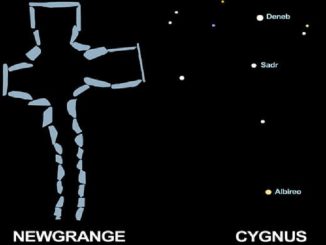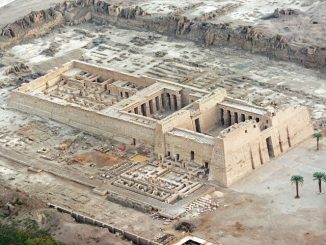Introduction
The excavation of the Oseberg Viking Ship in 1904 stands as one of the most pivotal archaeological discoveries of the early 20th century, providing an unparalleled glimpse into the Viking Age. Found in a burial mound near Tønsberg in Vestfold, Norway, the Oseberg Ship has since fascinated historians, archaeologists, and the public alike with its intricate craftsmanship and the treasures it contained. This blog post explores the historical context of the Oseberg Ship, the details and significance of its discovery, the insights gained from the artifacts found within, and the lasting impact of this remarkable find on our understanding of Viking culture.
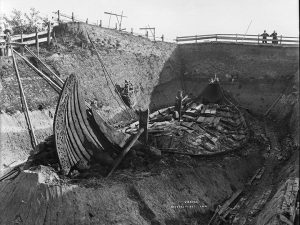
The Discovery of a Lifetime
The discovery of the Oseberg Ship was made by farmer Knut Rom on his land in the summer of 1903, but it wasn’t until 1904 that a full excavation, led by archaeologist Gabriel Gustafson, unveiled the ship in its entirety. Buried within a large mound and surrounded by clay and blue clay, the ship was remarkably well-preserved, offering a rare and almost intimate view of Viking shipbuilding techniques and funerary practices. The ship itself, a stunning example of Viking craftsmanship, featured intricate carvings that have captivated the imagination of all who lay eyes upon it. Images from the excavation reveal the meticulous process of uncovering the ship, showcasing the size, condition, and detail of the vessel as it emerged from its earthen tomb.
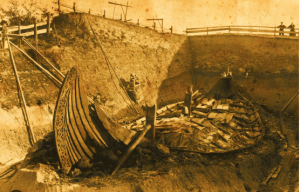
A Window into the Viking World
The Oseberg Ship was not just a maritime vessel; it was a treasure trove of artifacts that offered invaluable insights into Viking life and culture. Among the findings were textiles, wood carvings, and household utensils, along with two female skeletons that hinted at the ship’s function as a burial site. The variety and preservation of the artifacts suggest a high level of sophistication and artistry among the Vikings, challenging earlier stereotypes of these people as mere raiders and warriors. Through images of the artifacts, readers can explore the everyday life, religious beliefs, and social structures of the Viking Age, bringing us closer to understanding this complex and dynamic society.
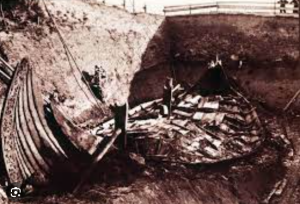
The Ship’s Journey to the Museum
After its excavation, the Oseberg Ship was transported to the Viking Ship Museum in Oslo, where it underwent conservation and became a centerpiece of the museum’s collection. The process of preserving and displaying the ship and its artifacts was a monumental task, requiring innovative techniques to ensure their long-term survival. Today, the Oseberg Ship continues to draw visitors from around the world, serving as a testament to Norway’s rich heritage and the enduring legacy of the Viking Age. Images of the ship within the museum context highlight the ongoing efforts to study and preserve this incredible piece of history for future generations.
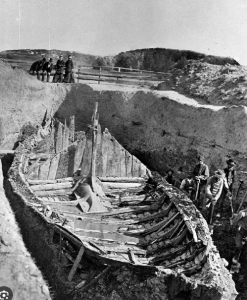
Reflecting on Ancient Discoveries
The excavation of the Oseberg Ship underscores the importance of archaeological discoveries in shaping our understanding of the past. Each artifact, from the smallest comb to the ship itself, tells a story that contributes to our collective knowledge of human history. The Oseberg find, in particular, has played a crucial role in redefining perceptions of the Viking Age, offering evidence of the Norse people’s artistry, maritime skills, and social customs. As we continue to uncover and study ancient artifacts, we are reminded of the complex tapestry of human civilization and the ways in which our ancestors continue to speak to us across the ages.
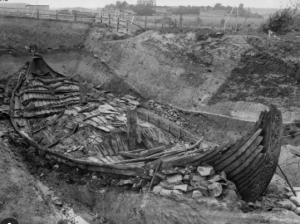
Conclusion
The Oseberg Viking Ship excavation in 1904 opened a window into the past that has profoundly enriched our understanding of Viking culture and history. Beyond its immediate archaeological significance, the ship serves as a symbol of exploration, craftsmanship, and the human impulse to commemorate the dead. Through the ongoing study and preservation of the Oseberg Ship and its artifacts, we continue to uncover layers of meaning and connection to our ancient forebears, reaffirming the value of archaeological inquiry in bridging the gap between past and present. As we look back on the discovery of the Oseberg Ship, we are reminded of the enduring power of the past to inform, inspire, and intrigue.

